Strategic Management Report: PepsiCo's Competitive Strategies Analysis
VerifiedAdded on 2020/04/01
|15
|3858
|28
Report
AI Summary
This report provides a strategic management analysis of PepsiCo, examining its organizational overview, corporate governance, and sources of competitive advantage. It delves into the company's differentiation and cost advantages within the food and beverage industry, highlighting its manufacturing and branding capabilities. The report includes a competitor analysis, focusing on The Coca-Cola Company and other local competitors, along with an assessment of PepsiCo's market share. A value chain analysis is conducted to identify sources of competitive advantage, followed by a VIRO analysis to evaluate the sustainability of these advantages. The report concludes with recommendations on strategies to enhance PepsiCo's competitiveness, offering insights into how the company can maintain its market position. This report is available on Desklib, a platform offering study resources.
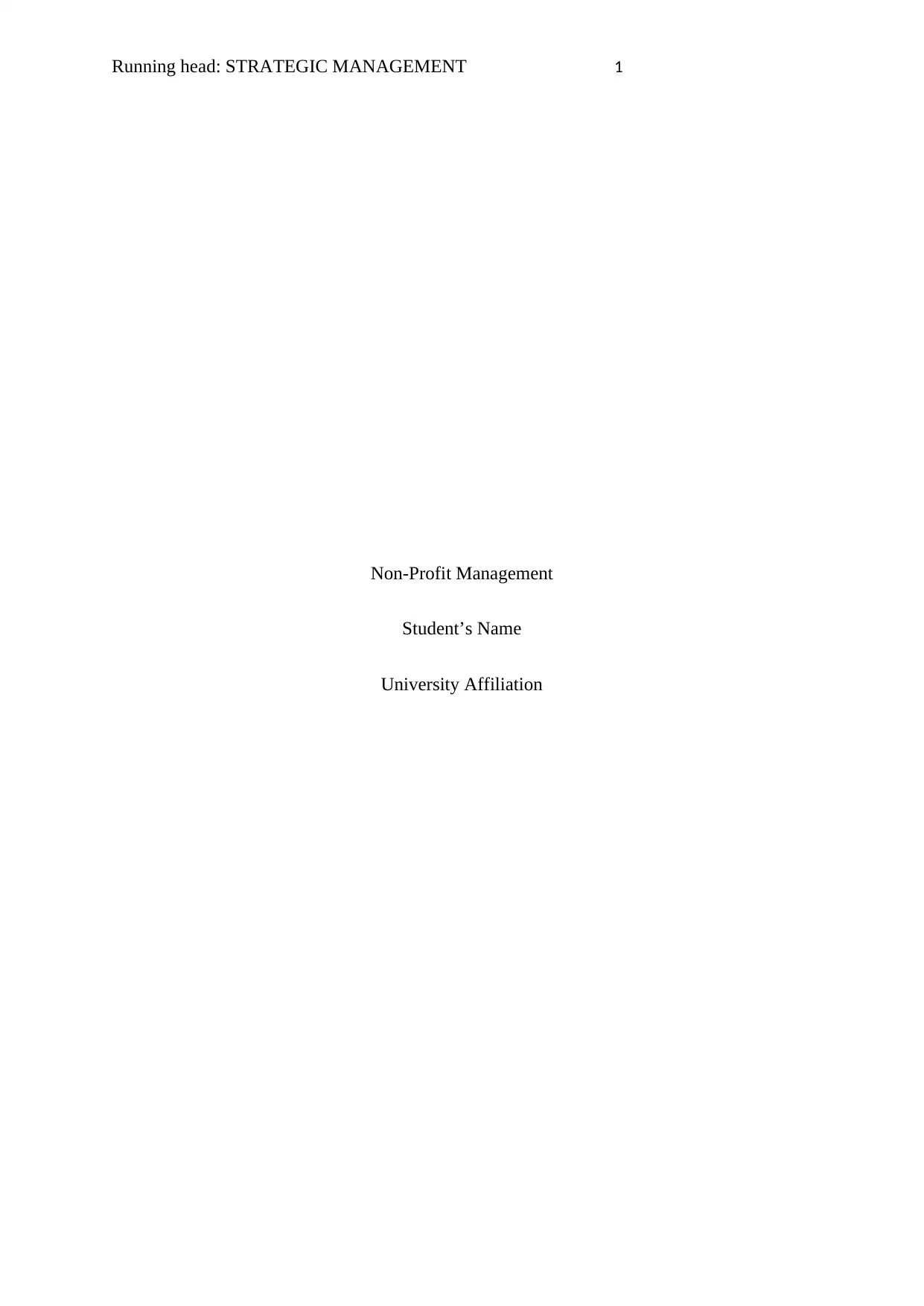
Running head: STRATEGIC MANAGEMENT 1
Non-Profit Management
Student’s Name
University Affiliation
Non-Profit Management
Student’s Name
University Affiliation
Paraphrase This Document
Need a fresh take? Get an instant paraphrase of this document with our AI Paraphraser
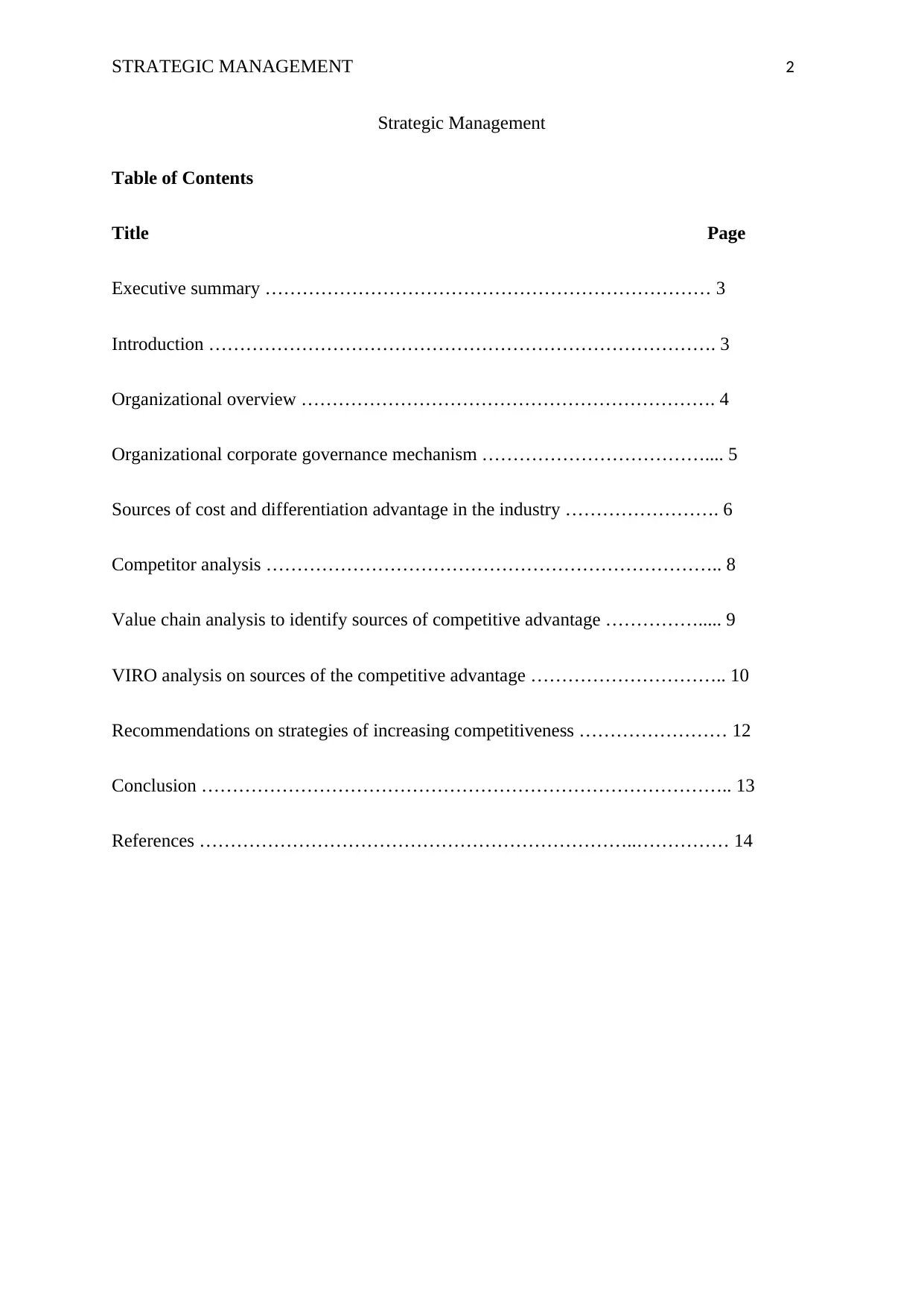
STRATEGIC MANAGEMENT 2
Strategic Management
Table of Contents
Title Page
Executive summary ……………………………………………………………… 3
Introduction ………………………………………………………………………. 3
Organizational overview …………………………………………………………. 4
Organizational corporate governance mechanism ……………………………….... 5
Sources of cost and differentiation advantage in the industry ……………………. 6
Competitor analysis ……………………………………………………………….. 8
Value chain analysis to identify sources of competitive advantage ……………..... 9
VIRO analysis on sources of the competitive advantage ………………………….. 10
Recommendations on strategies of increasing competitiveness …………………… 12
Conclusion ………………………………………………………………………….. 13
References ……………………………………………………………..…………… 14
Strategic Management
Table of Contents
Title Page
Executive summary ……………………………………………………………… 3
Introduction ………………………………………………………………………. 3
Organizational overview …………………………………………………………. 4
Organizational corporate governance mechanism ……………………………….... 5
Sources of cost and differentiation advantage in the industry ……………………. 6
Competitor analysis ……………………………………………………………….. 8
Value chain analysis to identify sources of competitive advantage ……………..... 9
VIRO analysis on sources of the competitive advantage ………………………….. 10
Recommendations on strategies of increasing competitiveness …………………… 12
Conclusion ………………………………………………………………………….. 13
References ……………………………………………………………..…………… 14
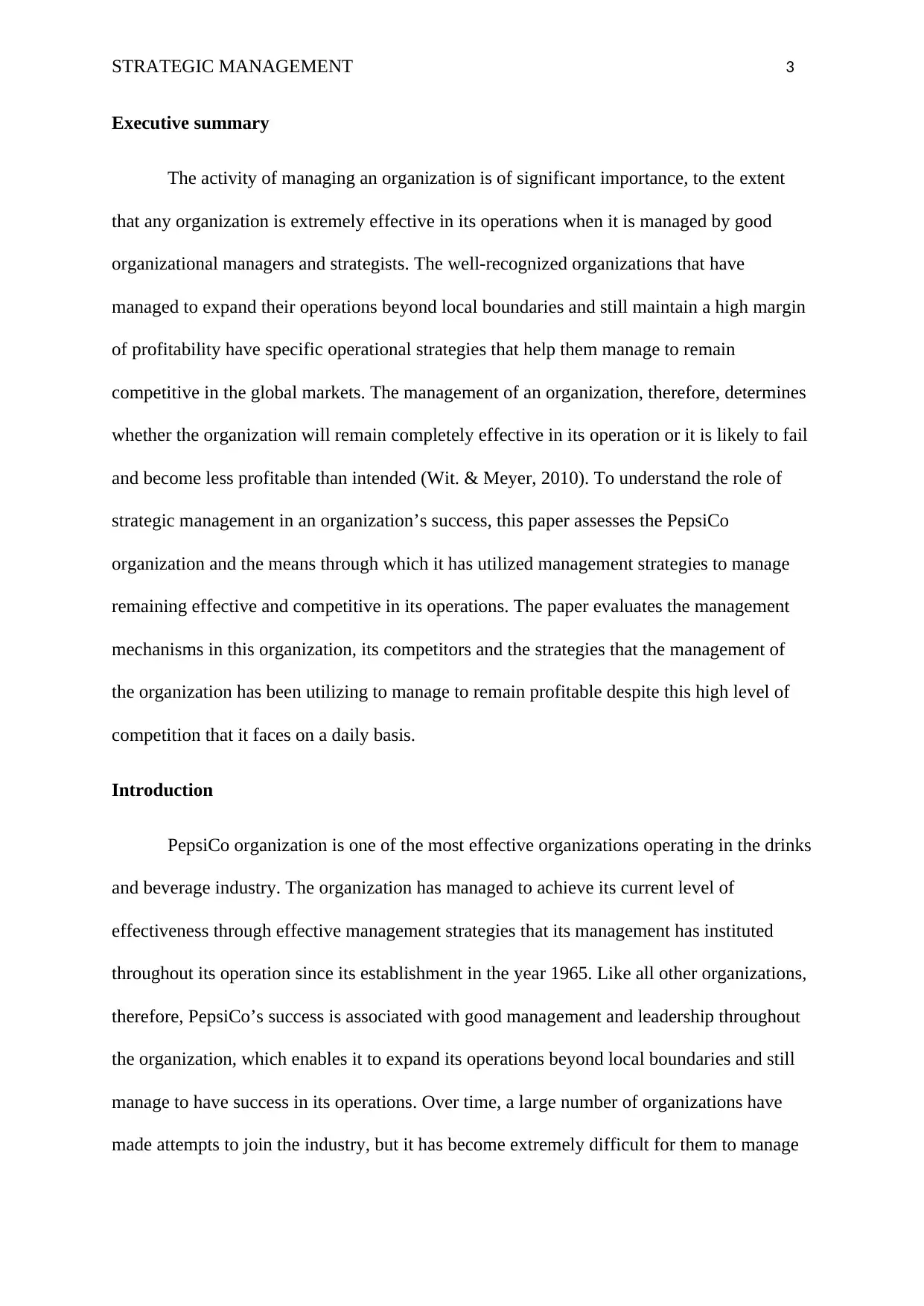
STRATEGIC MANAGEMENT 3
Executive summary
The activity of managing an organization is of significant importance, to the extent
that any organization is extremely effective in its operations when it is managed by good
organizational managers and strategists. The well-recognized organizations that have
managed to expand their operations beyond local boundaries and still maintain a high margin
of profitability have specific operational strategies that help them manage to remain
competitive in the global markets. The management of an organization, therefore, determines
whether the organization will remain completely effective in its operation or it is likely to fail
and become less profitable than intended (Wit. & Meyer, 2010). To understand the role of
strategic management in an organization’s success, this paper assesses the PepsiCo
organization and the means through which it has utilized management strategies to manage
remaining effective and competitive in its operations. The paper evaluates the management
mechanisms in this organization, its competitors and the strategies that the management of
the organization has been utilizing to manage to remain profitable despite this high level of
competition that it faces on a daily basis.
Introduction
PepsiCo organization is one of the most effective organizations operating in the drinks
and beverage industry. The organization has managed to achieve its current level of
effectiveness through effective management strategies that its management has instituted
throughout its operation since its establishment in the year 1965. Like all other organizations,
therefore, PepsiCo’s success is associated with good management and leadership throughout
the organization, which enables it to expand its operations beyond local boundaries and still
manage to have success in its operations. Over time, a large number of organizations have
made attempts to join the industry, but it has become extremely difficult for them to manage
Executive summary
The activity of managing an organization is of significant importance, to the extent
that any organization is extremely effective in its operations when it is managed by good
organizational managers and strategists. The well-recognized organizations that have
managed to expand their operations beyond local boundaries and still maintain a high margin
of profitability have specific operational strategies that help them manage to remain
competitive in the global markets. The management of an organization, therefore, determines
whether the organization will remain completely effective in its operation or it is likely to fail
and become less profitable than intended (Wit. & Meyer, 2010). To understand the role of
strategic management in an organization’s success, this paper assesses the PepsiCo
organization and the means through which it has utilized management strategies to manage
remaining effective and competitive in its operations. The paper evaluates the management
mechanisms in this organization, its competitors and the strategies that the management of
the organization has been utilizing to manage to remain profitable despite this high level of
competition that it faces on a daily basis.
Introduction
PepsiCo organization is one of the most effective organizations operating in the drinks
and beverage industry. The organization has managed to achieve its current level of
effectiveness through effective management strategies that its management has instituted
throughout its operation since its establishment in the year 1965. Like all other organizations,
therefore, PepsiCo’s success is associated with good management and leadership throughout
the organization, which enables it to expand its operations beyond local boundaries and still
manage to have success in its operations. Over time, a large number of organizations have
made attempts to join the industry, but it has become extremely difficult for them to manage
⊘ This is a preview!⊘
Do you want full access?
Subscribe today to unlock all pages.

Trusted by 1+ million students worldwide
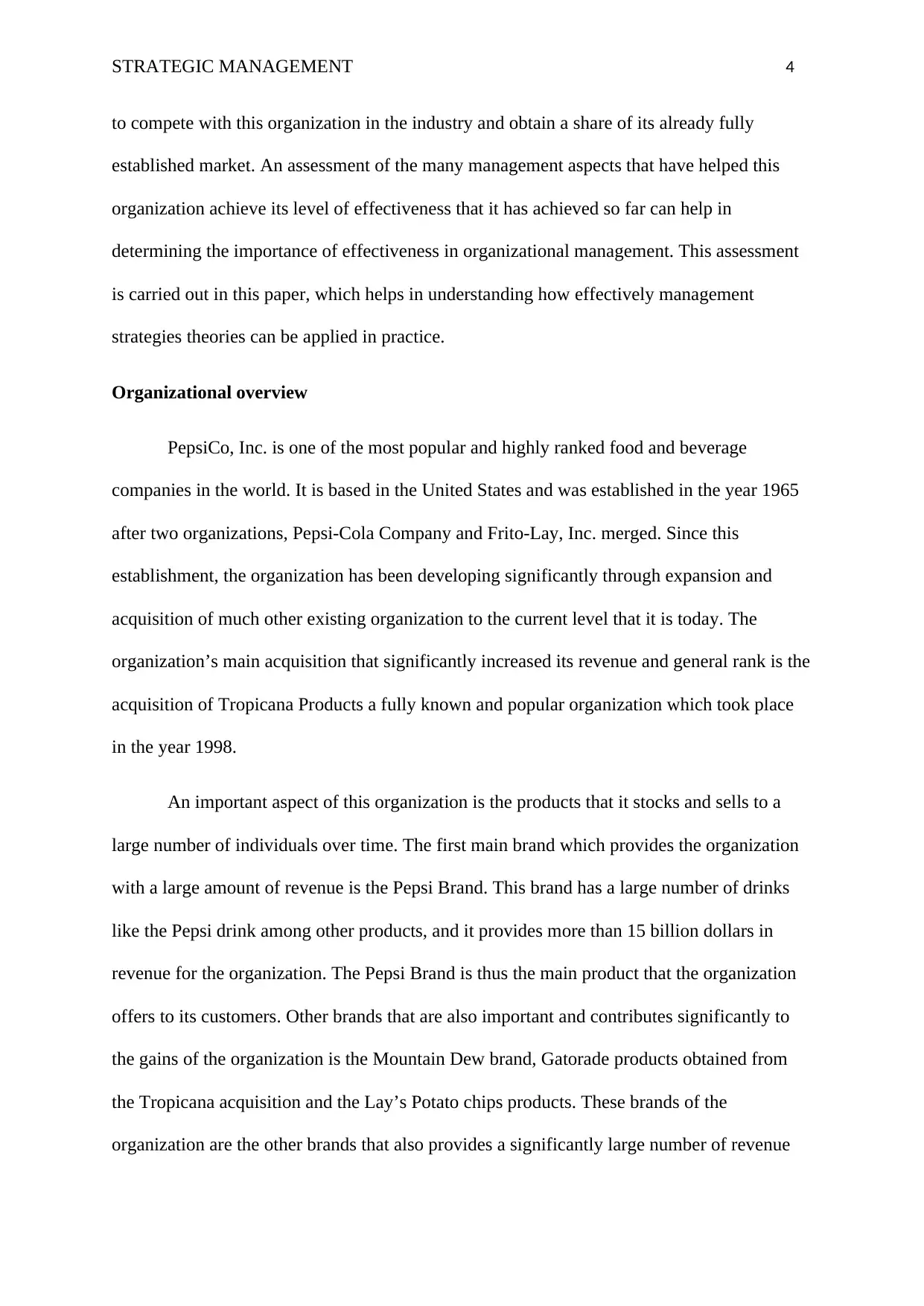
STRATEGIC MANAGEMENT 4
to compete with this organization in the industry and obtain a share of its already fully
established market. An assessment of the many management aspects that have helped this
organization achieve its level of effectiveness that it has achieved so far can help in
determining the importance of effectiveness in organizational management. This assessment
is carried out in this paper, which helps in understanding how effectively management
strategies theories can be applied in practice.
Organizational overview
PepsiCo, Inc. is one of the most popular and highly ranked food and beverage
companies in the world. It is based in the United States and was established in the year 1965
after two organizations, Pepsi-Cola Company and Frito-Lay, Inc. merged. Since this
establishment, the organization has been developing significantly through expansion and
acquisition of much other existing organization to the current level that it is today. The
organization’s main acquisition that significantly increased its revenue and general rank is the
acquisition of Tropicana Products a fully known and popular organization which took place
in the year 1998.
An important aspect of this organization is the products that it stocks and sells to a
large number of individuals over time. The first main brand which provides the organization
with a large amount of revenue is the Pepsi Brand. This brand has a large number of drinks
like the Pepsi drink among other products, and it provides more than 15 billion dollars in
revenue for the organization. The Pepsi Brand is thus the main product that the organization
offers to its customers. Other brands that are also important and contributes significantly to
the gains of the organization is the Mountain Dew brand, Gatorade products obtained from
the Tropicana acquisition and the Lay’s Potato chips products. These brands of the
organization are the other brands that also provides a significantly large number of revenue
to compete with this organization in the industry and obtain a share of its already fully
established market. An assessment of the many management aspects that have helped this
organization achieve its level of effectiveness that it has achieved so far can help in
determining the importance of effectiveness in organizational management. This assessment
is carried out in this paper, which helps in understanding how effectively management
strategies theories can be applied in practice.
Organizational overview
PepsiCo, Inc. is one of the most popular and highly ranked food and beverage
companies in the world. It is based in the United States and was established in the year 1965
after two organizations, Pepsi-Cola Company and Frito-Lay, Inc. merged. Since this
establishment, the organization has been developing significantly through expansion and
acquisition of much other existing organization to the current level that it is today. The
organization’s main acquisition that significantly increased its revenue and general rank is the
acquisition of Tropicana Products a fully known and popular organization which took place
in the year 1998.
An important aspect of this organization is the products that it stocks and sells to a
large number of individuals over time. The first main brand which provides the organization
with a large amount of revenue is the Pepsi Brand. This brand has a large number of drinks
like the Pepsi drink among other products, and it provides more than 15 billion dollars in
revenue for the organization. The Pepsi Brand is thus the main product that the organization
offers to its customers. Other brands that are also important and contributes significantly to
the gains of the organization is the Mountain Dew brand, Gatorade products obtained from
the Tropicana acquisition and the Lay’s Potato chips products. These brands of the
organization are the other brands that also provides a significantly large number of revenue
Paraphrase This Document
Need a fresh take? Get an instant paraphrase of this document with our AI Paraphraser
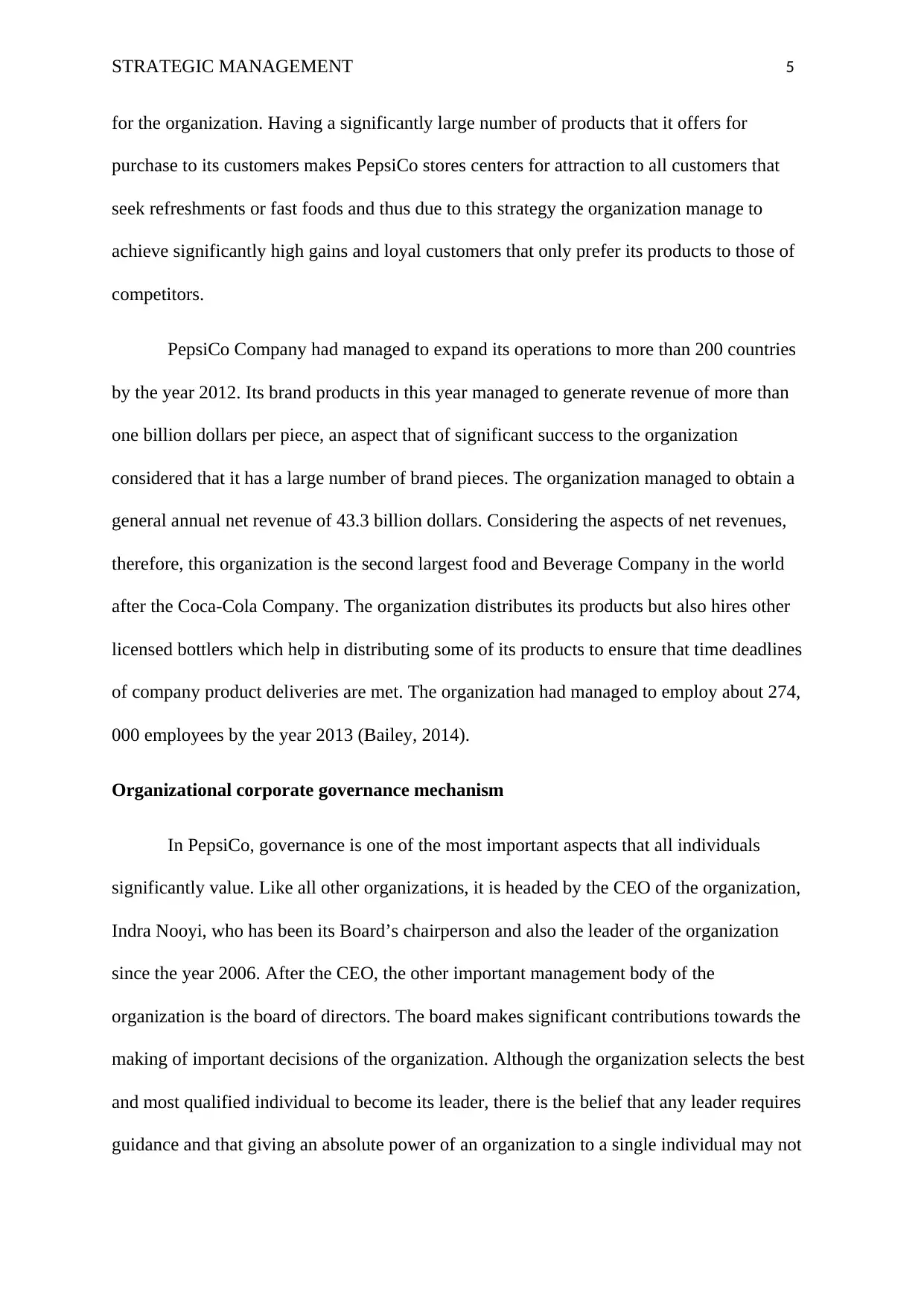
STRATEGIC MANAGEMENT 5
for the organization. Having a significantly large number of products that it offers for
purchase to its customers makes PepsiCo stores centers for attraction to all customers that
seek refreshments or fast foods and thus due to this strategy the organization manage to
achieve significantly high gains and loyal customers that only prefer its products to those of
competitors.
PepsiCo Company had managed to expand its operations to more than 200 countries
by the year 2012. Its brand products in this year managed to generate revenue of more than
one billion dollars per piece, an aspect that of significant success to the organization
considered that it has a large number of brand pieces. The organization managed to obtain a
general annual net revenue of 43.3 billion dollars. Considering the aspects of net revenues,
therefore, this organization is the second largest food and Beverage Company in the world
after the Coca-Cola Company. The organization distributes its products but also hires other
licensed bottlers which help in distributing some of its products to ensure that time deadlines
of company product deliveries are met. The organization had managed to employ about 274,
000 employees by the year 2013 (Bailey, 2014).
Organizational corporate governance mechanism
In PepsiCo, governance is one of the most important aspects that all individuals
significantly value. Like all other organizations, it is headed by the CEO of the organization,
Indra Nooyi, who has been its Board’s chairperson and also the leader of the organization
since the year 2006. After the CEO, the other important management body of the
organization is the board of directors. The board makes significant contributions towards the
making of important decisions of the organization. Although the organization selects the best
and most qualified individual to become its leader, there is the belief that any leader requires
guidance and that giving an absolute power of an organization to a single individual may not
for the organization. Having a significantly large number of products that it offers for
purchase to its customers makes PepsiCo stores centers for attraction to all customers that
seek refreshments or fast foods and thus due to this strategy the organization manage to
achieve significantly high gains and loyal customers that only prefer its products to those of
competitors.
PepsiCo Company had managed to expand its operations to more than 200 countries
by the year 2012. Its brand products in this year managed to generate revenue of more than
one billion dollars per piece, an aspect that of significant success to the organization
considered that it has a large number of brand pieces. The organization managed to obtain a
general annual net revenue of 43.3 billion dollars. Considering the aspects of net revenues,
therefore, this organization is the second largest food and Beverage Company in the world
after the Coca-Cola Company. The organization distributes its products but also hires other
licensed bottlers which help in distributing some of its products to ensure that time deadlines
of company product deliveries are met. The organization had managed to employ about 274,
000 employees by the year 2013 (Bailey, 2014).
Organizational corporate governance mechanism
In PepsiCo, governance is one of the most important aspects that all individuals
significantly value. Like all other organizations, it is headed by the CEO of the organization,
Indra Nooyi, who has been its Board’s chairperson and also the leader of the organization
since the year 2006. After the CEO, the other important management body of the
organization is the board of directors. The board makes significant contributions towards the
making of important decisions of the organization. Although the organization selects the best
and most qualified individual to become its leader, there is the belief that any leader requires
guidance and that giving an absolute power of an organization to a single individual may not
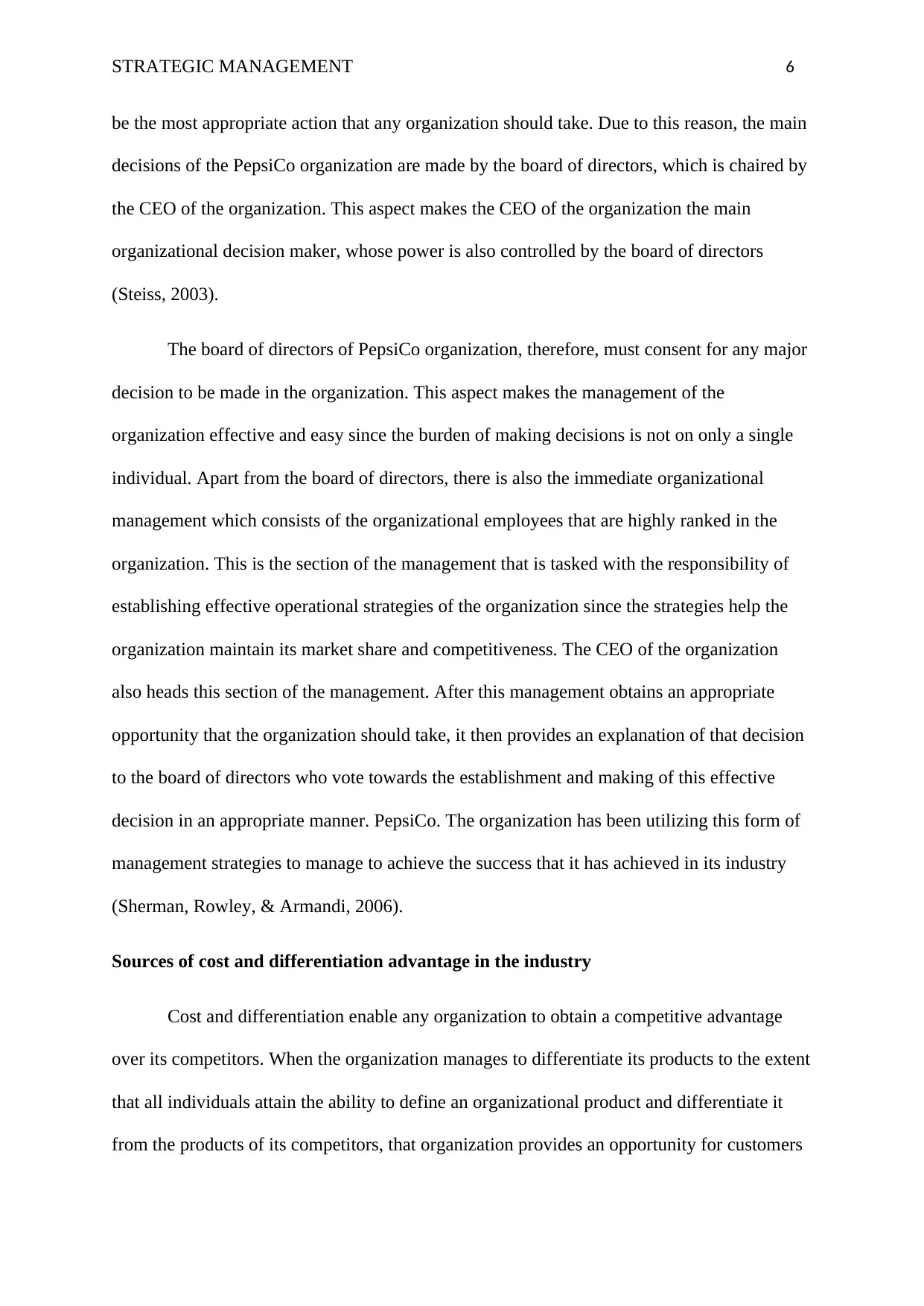
STRATEGIC MANAGEMENT 6
be the most appropriate action that any organization should take. Due to this reason, the main
decisions of the PepsiCo organization are made by the board of directors, which is chaired by
the CEO of the organization. This aspect makes the CEO of the organization the main
organizational decision maker, whose power is also controlled by the board of directors
(Steiss, 2003).
The board of directors of PepsiCo organization, therefore, must consent for any major
decision to be made in the organization. This aspect makes the management of the
organization effective and easy since the burden of making decisions is not on only a single
individual. Apart from the board of directors, there is also the immediate organizational
management which consists of the organizational employees that are highly ranked in the
organization. This is the section of the management that is tasked with the responsibility of
establishing effective operational strategies of the organization since the strategies help the
organization maintain its market share and competitiveness. The CEO of the organization
also heads this section of the management. After this management obtains an appropriate
opportunity that the organization should take, it then provides an explanation of that decision
to the board of directors who vote towards the establishment and making of this effective
decision in an appropriate manner. PepsiCo. The organization has been utilizing this form of
management strategies to manage to achieve the success that it has achieved in its industry
(Sherman, Rowley, & Armandi, 2006).
Sources of cost and differentiation advantage in the industry
Cost and differentiation enable any organization to obtain a competitive advantage
over its competitors. When the organization manages to differentiate its products to the extent
that all individuals attain the ability to define an organizational product and differentiate it
from the products of its competitors, that organization provides an opportunity for customers
be the most appropriate action that any organization should take. Due to this reason, the main
decisions of the PepsiCo organization are made by the board of directors, which is chaired by
the CEO of the organization. This aspect makes the CEO of the organization the main
organizational decision maker, whose power is also controlled by the board of directors
(Steiss, 2003).
The board of directors of PepsiCo organization, therefore, must consent for any major
decision to be made in the organization. This aspect makes the management of the
organization effective and easy since the burden of making decisions is not on only a single
individual. Apart from the board of directors, there is also the immediate organizational
management which consists of the organizational employees that are highly ranked in the
organization. This is the section of the management that is tasked with the responsibility of
establishing effective operational strategies of the organization since the strategies help the
organization maintain its market share and competitiveness. The CEO of the organization
also heads this section of the management. After this management obtains an appropriate
opportunity that the organization should take, it then provides an explanation of that decision
to the board of directors who vote towards the establishment and making of this effective
decision in an appropriate manner. PepsiCo. The organization has been utilizing this form of
management strategies to manage to achieve the success that it has achieved in its industry
(Sherman, Rowley, & Armandi, 2006).
Sources of cost and differentiation advantage in the industry
Cost and differentiation enable any organization to obtain a competitive advantage
over its competitors. When the organization manages to differentiate its products to the extent
that all individuals attain the ability to define an organizational product and differentiate it
from the products of its competitors, that organization provides an opportunity for customers
⊘ This is a preview!⊘
Do you want full access?
Subscribe today to unlock all pages.

Trusted by 1+ million students worldwide
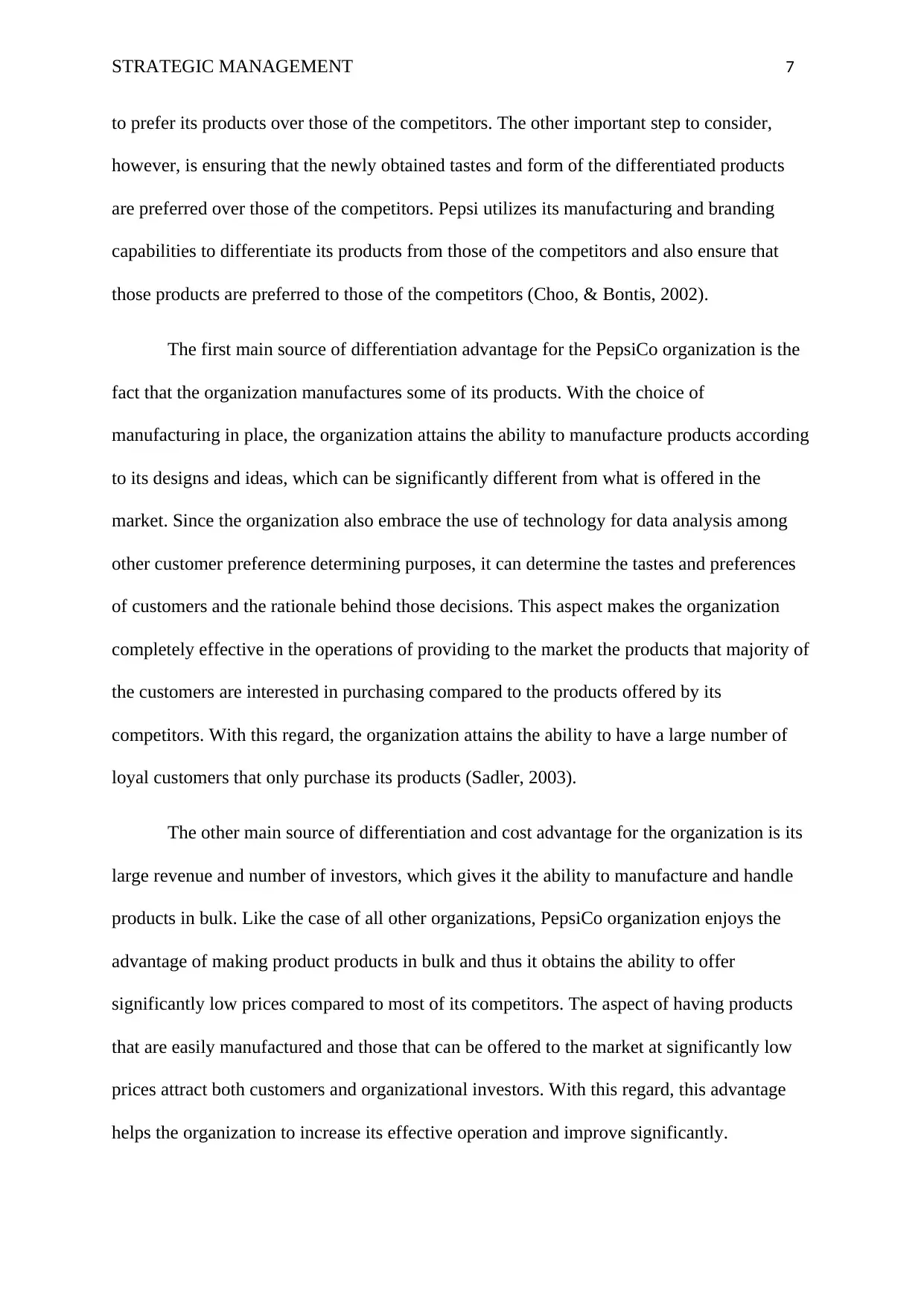
STRATEGIC MANAGEMENT 7
to prefer its products over those of the competitors. The other important step to consider,
however, is ensuring that the newly obtained tastes and form of the differentiated products
are preferred over those of the competitors. Pepsi utilizes its manufacturing and branding
capabilities to differentiate its products from those of the competitors and also ensure that
those products are preferred to those of the competitors (Choo, & Bontis, 2002).
The first main source of differentiation advantage for the PepsiCo organization is the
fact that the organization manufactures some of its products. With the choice of
manufacturing in place, the organization attains the ability to manufacture products according
to its designs and ideas, which can be significantly different from what is offered in the
market. Since the organization also embrace the use of technology for data analysis among
other customer preference determining purposes, it can determine the tastes and preferences
of customers and the rationale behind those decisions. This aspect makes the organization
completely effective in the operations of providing to the market the products that majority of
the customers are interested in purchasing compared to the products offered by its
competitors. With this regard, the organization attains the ability to have a large number of
loyal customers that only purchase its products (Sadler, 2003).
The other main source of differentiation and cost advantage for the organization is its
large revenue and number of investors, which gives it the ability to manufacture and handle
products in bulk. Like the case of all other organizations, PepsiCo organization enjoys the
advantage of making product products in bulk and thus it obtains the ability to offer
significantly low prices compared to most of its competitors. The aspect of having products
that are easily manufactured and those that can be offered to the market at significantly low
prices attract both customers and organizational investors. With this regard, this advantage
helps the organization to increase its effective operation and improve significantly.
to prefer its products over those of the competitors. The other important step to consider,
however, is ensuring that the newly obtained tastes and form of the differentiated products
are preferred over those of the competitors. Pepsi utilizes its manufacturing and branding
capabilities to differentiate its products from those of the competitors and also ensure that
those products are preferred to those of the competitors (Choo, & Bontis, 2002).
The first main source of differentiation advantage for the PepsiCo organization is the
fact that the organization manufactures some of its products. With the choice of
manufacturing in place, the organization attains the ability to manufacture products according
to its designs and ideas, which can be significantly different from what is offered in the
market. Since the organization also embrace the use of technology for data analysis among
other customer preference determining purposes, it can determine the tastes and preferences
of customers and the rationale behind those decisions. This aspect makes the organization
completely effective in the operations of providing to the market the products that majority of
the customers are interested in purchasing compared to the products offered by its
competitors. With this regard, the organization attains the ability to have a large number of
loyal customers that only purchase its products (Sadler, 2003).
The other main source of differentiation and cost advantage for the organization is its
large revenue and number of investors, which gives it the ability to manufacture and handle
products in bulk. Like the case of all other organizations, PepsiCo organization enjoys the
advantage of making product products in bulk and thus it obtains the ability to offer
significantly low prices compared to most of its competitors. The aspect of having products
that are easily manufactured and those that can be offered to the market at significantly low
prices attract both customers and organizational investors. With this regard, this advantage
helps the organization to increase its effective operation and improve significantly.
Paraphrase This Document
Need a fresh take? Get an instant paraphrase of this document with our AI Paraphraser
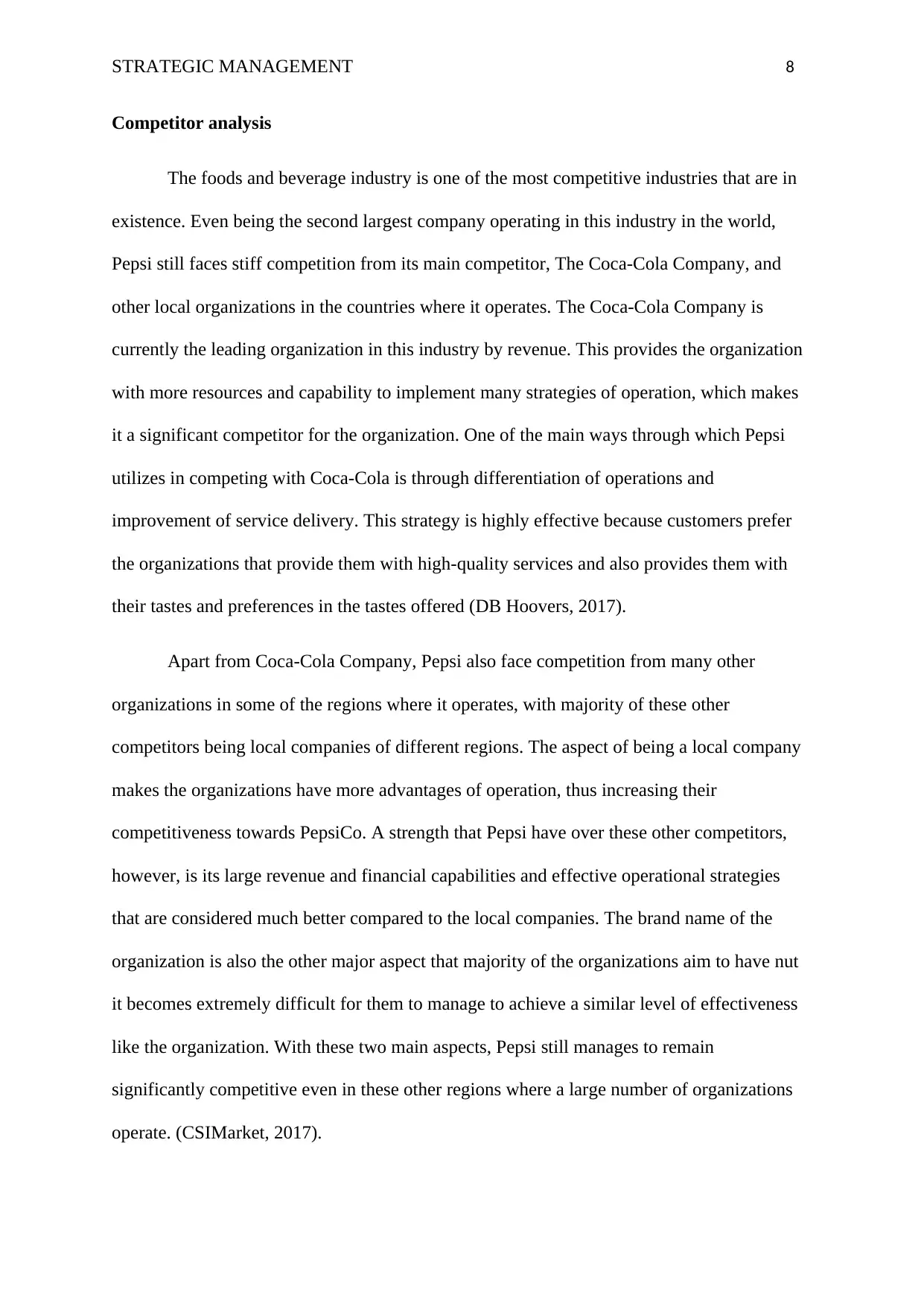
STRATEGIC MANAGEMENT 8
Competitor analysis
The foods and beverage industry is one of the most competitive industries that are in
existence. Even being the second largest company operating in this industry in the world,
Pepsi still faces stiff competition from its main competitor, The Coca-Cola Company, and
other local organizations in the countries where it operates. The Coca-Cola Company is
currently the leading organization in this industry by revenue. This provides the organization
with more resources and capability to implement many strategies of operation, which makes
it a significant competitor for the organization. One of the main ways through which Pepsi
utilizes in competing with Coca-Cola is through differentiation of operations and
improvement of service delivery. This strategy is highly effective because customers prefer
the organizations that provide them with high-quality services and also provides them with
their tastes and preferences in the tastes offered (DB Hoovers, 2017).
Apart from Coca-Cola Company, Pepsi also face competition from many other
organizations in some of the regions where it operates, with majority of these other
competitors being local companies of different regions. The aspect of being a local company
makes the organizations have more advantages of operation, thus increasing their
competitiveness towards PepsiCo. A strength that Pepsi have over these other competitors,
however, is its large revenue and financial capabilities and effective operational strategies
that are considered much better compared to the local companies. The brand name of the
organization is also the other major aspect that majority of the organizations aim to have nut
it becomes extremely difficult for them to manage to achieve a similar level of effectiveness
like the organization. With these two main aspects, Pepsi still manages to remain
significantly competitive even in these other regions where a large number of organizations
operate. (CSIMarket, 2017).
Competitor analysis
The foods and beverage industry is one of the most competitive industries that are in
existence. Even being the second largest company operating in this industry in the world,
Pepsi still faces stiff competition from its main competitor, The Coca-Cola Company, and
other local organizations in the countries where it operates. The Coca-Cola Company is
currently the leading organization in this industry by revenue. This provides the organization
with more resources and capability to implement many strategies of operation, which makes
it a significant competitor for the organization. One of the main ways through which Pepsi
utilizes in competing with Coca-Cola is through differentiation of operations and
improvement of service delivery. This strategy is highly effective because customers prefer
the organizations that provide them with high-quality services and also provides them with
their tastes and preferences in the tastes offered (DB Hoovers, 2017).
Apart from Coca-Cola Company, Pepsi also face competition from many other
organizations in some of the regions where it operates, with majority of these other
competitors being local companies of different regions. The aspect of being a local company
makes the organizations have more advantages of operation, thus increasing their
competitiveness towards PepsiCo. A strength that Pepsi have over these other competitors,
however, is its large revenue and financial capabilities and effective operational strategies
that are considered much better compared to the local companies. The brand name of the
organization is also the other major aspect that majority of the organizations aim to have nut
it becomes extremely difficult for them to manage to achieve a similar level of effectiveness
like the organization. With these two main aspects, Pepsi still manages to remain
significantly competitive even in these other regions where a large number of organizations
operate. (CSIMarket, 2017).
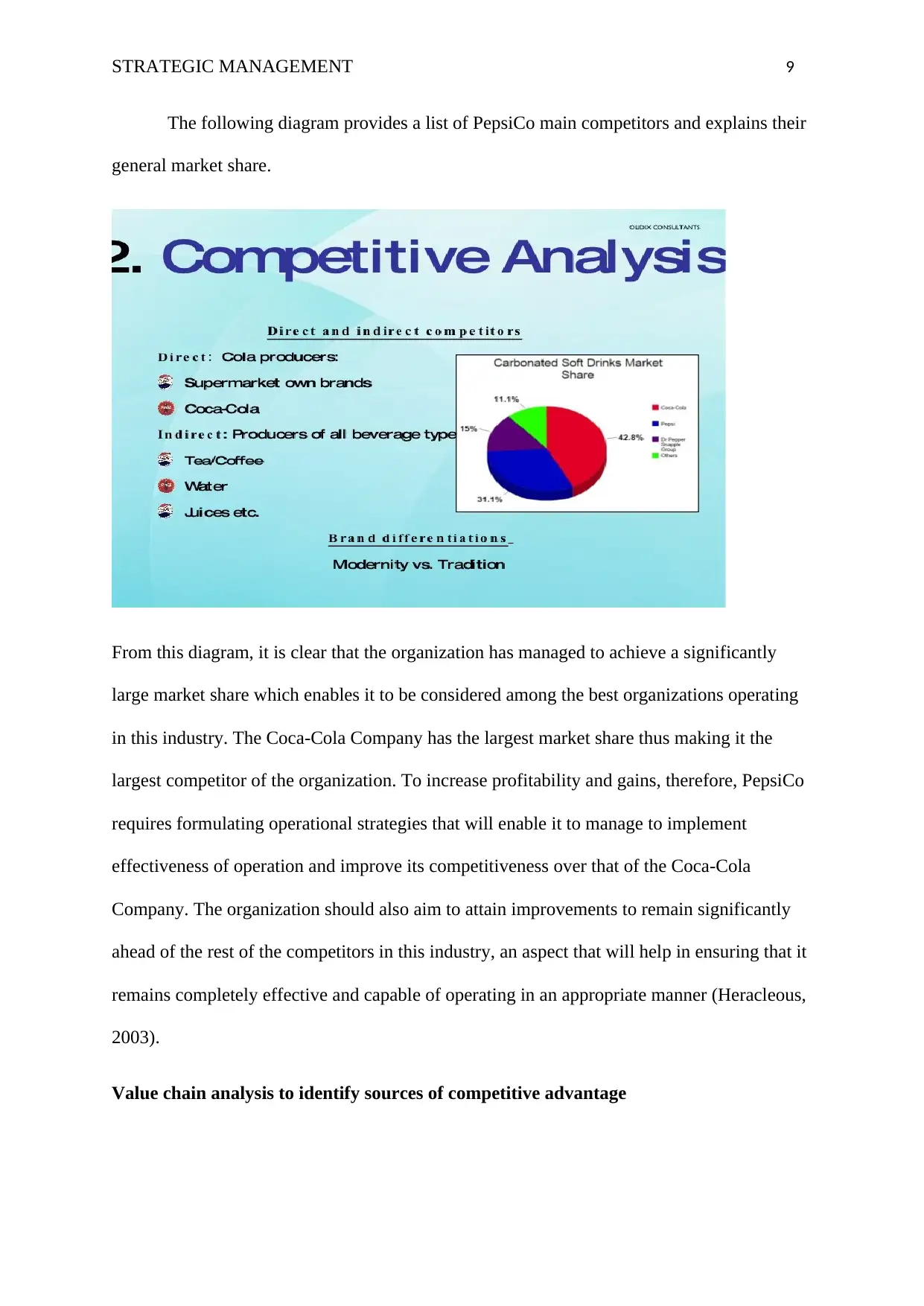
STRATEGIC MANAGEMENT 9
The following diagram provides a list of PepsiCo main competitors and explains their
general market share.
From this diagram, it is clear that the organization has managed to achieve a significantly
large market share which enables it to be considered among the best organizations operating
in this industry. The Coca-Cola Company has the largest market share thus making it the
largest competitor of the organization. To increase profitability and gains, therefore, PepsiCo
requires formulating operational strategies that will enable it to manage to implement
effectiveness of operation and improve its competitiveness over that of the Coca-Cola
Company. The organization should also aim to attain improvements to remain significantly
ahead of the rest of the competitors in this industry, an aspect that will help in ensuring that it
remains completely effective and capable of operating in an appropriate manner (Heracleous,
2003).
Value chain analysis to identify sources of competitive advantage
The following diagram provides a list of PepsiCo main competitors and explains their
general market share.
From this diagram, it is clear that the organization has managed to achieve a significantly
large market share which enables it to be considered among the best organizations operating
in this industry. The Coca-Cola Company has the largest market share thus making it the
largest competitor of the organization. To increase profitability and gains, therefore, PepsiCo
requires formulating operational strategies that will enable it to manage to implement
effectiveness of operation and improve its competitiveness over that of the Coca-Cola
Company. The organization should also aim to attain improvements to remain significantly
ahead of the rest of the competitors in this industry, an aspect that will help in ensuring that it
remains completely effective and capable of operating in an appropriate manner (Heracleous,
2003).
Value chain analysis to identify sources of competitive advantage
⊘ This is a preview!⊘
Do you want full access?
Subscribe today to unlock all pages.

Trusted by 1+ million students worldwide
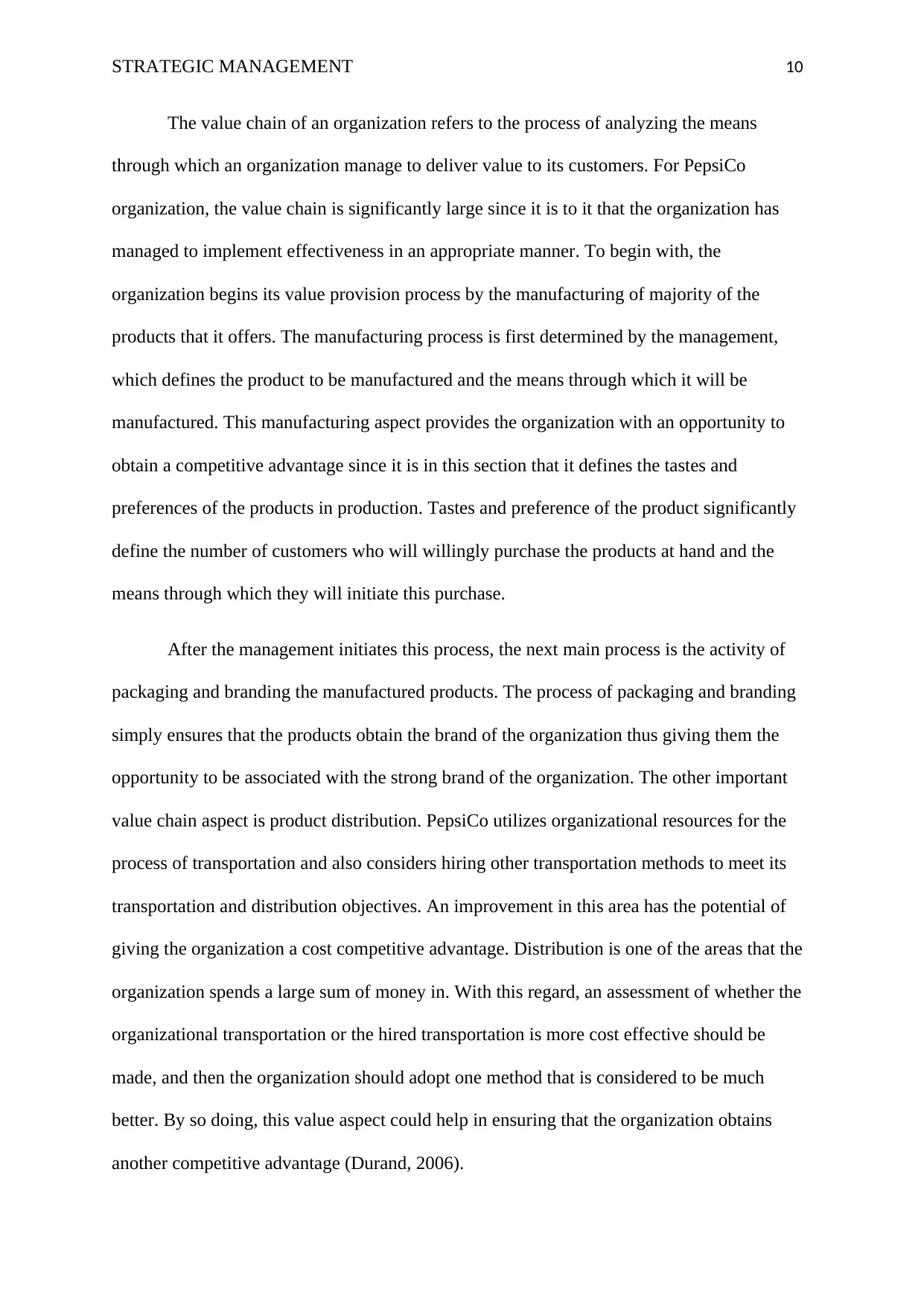
STRATEGIC MANAGEMENT 10
The value chain of an organization refers to the process of analyzing the means
through which an organization manage to deliver value to its customers. For PepsiCo
organization, the value chain is significantly large since it is to it that the organization has
managed to implement effectiveness in an appropriate manner. To begin with, the
organization begins its value provision process by the manufacturing of majority of the
products that it offers. The manufacturing process is first determined by the management,
which defines the product to be manufactured and the means through which it will be
manufactured. This manufacturing aspect provides the organization with an opportunity to
obtain a competitive advantage since it is in this section that it defines the tastes and
preferences of the products in production. Tastes and preference of the product significantly
define the number of customers who will willingly purchase the products at hand and the
means through which they will initiate this purchase.
After the management initiates this process, the next main process is the activity of
packaging and branding the manufactured products. The process of packaging and branding
simply ensures that the products obtain the brand of the organization thus giving them the
opportunity to be associated with the strong brand of the organization. The other important
value chain aspect is product distribution. PepsiCo utilizes organizational resources for the
process of transportation and also considers hiring other transportation methods to meet its
transportation and distribution objectives. An improvement in this area has the potential of
giving the organization a cost competitive advantage. Distribution is one of the areas that the
organization spends a large sum of money in. With this regard, an assessment of whether the
organizational transportation or the hired transportation is more cost effective should be
made, and then the organization should adopt one method that is considered to be much
better. By so doing, this value aspect could help in ensuring that the organization obtains
another competitive advantage (Durand, 2006).
The value chain of an organization refers to the process of analyzing the means
through which an organization manage to deliver value to its customers. For PepsiCo
organization, the value chain is significantly large since it is to it that the organization has
managed to implement effectiveness in an appropriate manner. To begin with, the
organization begins its value provision process by the manufacturing of majority of the
products that it offers. The manufacturing process is first determined by the management,
which defines the product to be manufactured and the means through which it will be
manufactured. This manufacturing aspect provides the organization with an opportunity to
obtain a competitive advantage since it is in this section that it defines the tastes and
preferences of the products in production. Tastes and preference of the product significantly
define the number of customers who will willingly purchase the products at hand and the
means through which they will initiate this purchase.
After the management initiates this process, the next main process is the activity of
packaging and branding the manufactured products. The process of packaging and branding
simply ensures that the products obtain the brand of the organization thus giving them the
opportunity to be associated with the strong brand of the organization. The other important
value chain aspect is product distribution. PepsiCo utilizes organizational resources for the
process of transportation and also considers hiring other transportation methods to meet its
transportation and distribution objectives. An improvement in this area has the potential of
giving the organization a cost competitive advantage. Distribution is one of the areas that the
organization spends a large sum of money in. With this regard, an assessment of whether the
organizational transportation or the hired transportation is more cost effective should be
made, and then the organization should adopt one method that is considered to be much
better. By so doing, this value aspect could help in ensuring that the organization obtains
another competitive advantage (Durand, 2006).
Paraphrase This Document
Need a fresh take? Get an instant paraphrase of this document with our AI Paraphraser
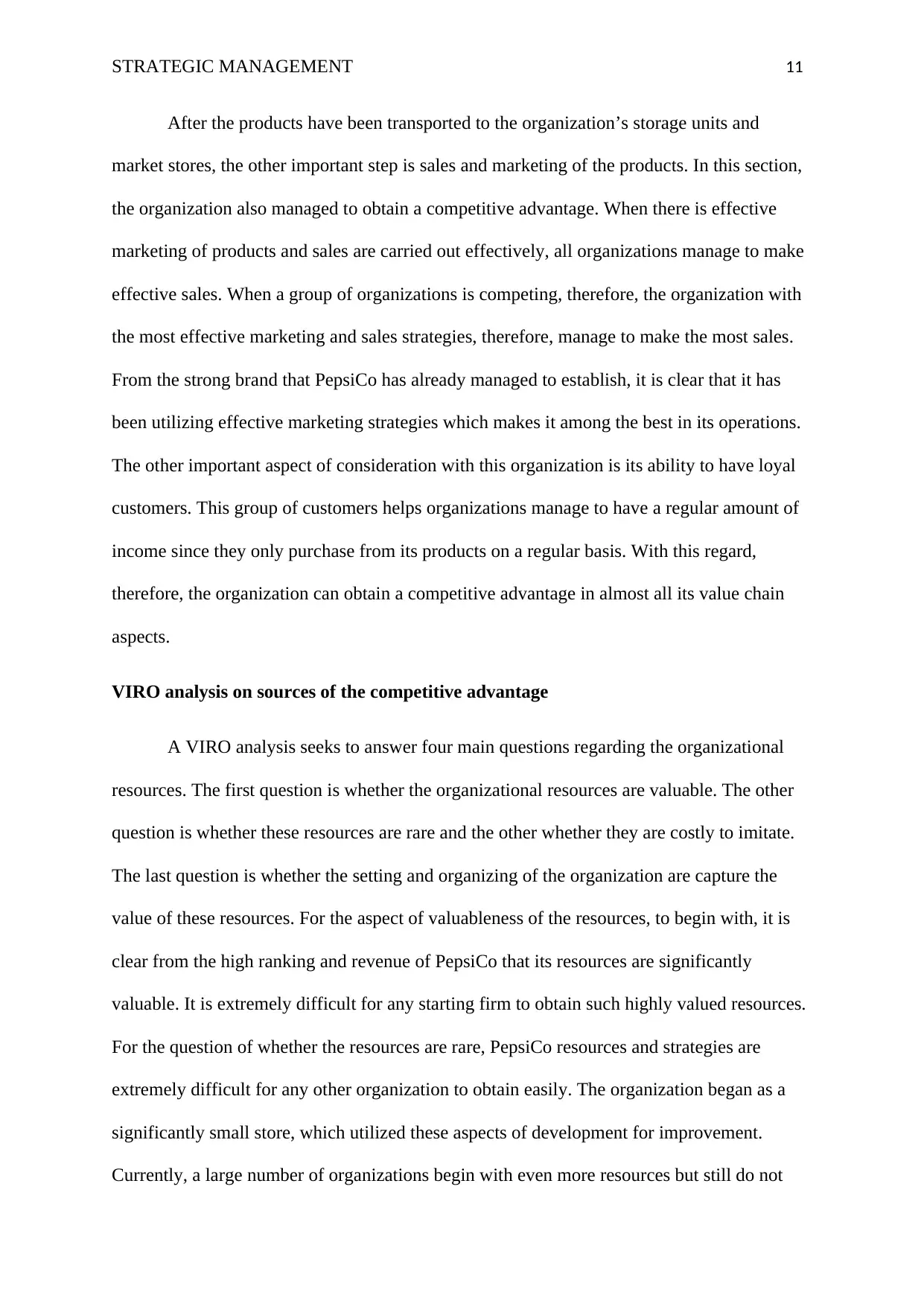
STRATEGIC MANAGEMENT 11
After the products have been transported to the organization’s storage units and
market stores, the other important step is sales and marketing of the products. In this section,
the organization also managed to obtain a competitive advantage. When there is effective
marketing of products and sales are carried out effectively, all organizations manage to make
effective sales. When a group of organizations is competing, therefore, the organization with
the most effective marketing and sales strategies, therefore, manage to make the most sales.
From the strong brand that PepsiCo has already managed to establish, it is clear that it has
been utilizing effective marketing strategies which makes it among the best in its operations.
The other important aspect of consideration with this organization is its ability to have loyal
customers. This group of customers helps organizations manage to have a regular amount of
income since they only purchase from its products on a regular basis. With this regard,
therefore, the organization can obtain a competitive advantage in almost all its value chain
aspects.
VIRO analysis on sources of the competitive advantage
A VIRO analysis seeks to answer four main questions regarding the organizational
resources. The first question is whether the organizational resources are valuable. The other
question is whether these resources are rare and the other whether they are costly to imitate.
The last question is whether the setting and organizing of the organization are capture the
value of these resources. For the aspect of valuableness of the resources, to begin with, it is
clear from the high ranking and revenue of PepsiCo that its resources are significantly
valuable. It is extremely difficult for any starting firm to obtain such highly valued resources.
For the question of whether the resources are rare, PepsiCo resources and strategies are
extremely difficult for any other organization to obtain easily. The organization began as a
significantly small store, which utilized these aspects of development for improvement.
Currently, a large number of organizations begin with even more resources but still do not
After the products have been transported to the organization’s storage units and
market stores, the other important step is sales and marketing of the products. In this section,
the organization also managed to obtain a competitive advantage. When there is effective
marketing of products and sales are carried out effectively, all organizations manage to make
effective sales. When a group of organizations is competing, therefore, the organization with
the most effective marketing and sales strategies, therefore, manage to make the most sales.
From the strong brand that PepsiCo has already managed to establish, it is clear that it has
been utilizing effective marketing strategies which makes it among the best in its operations.
The other important aspect of consideration with this organization is its ability to have loyal
customers. This group of customers helps organizations manage to have a regular amount of
income since they only purchase from its products on a regular basis. With this regard,
therefore, the organization can obtain a competitive advantage in almost all its value chain
aspects.
VIRO analysis on sources of the competitive advantage
A VIRO analysis seeks to answer four main questions regarding the organizational
resources. The first question is whether the organizational resources are valuable. The other
question is whether these resources are rare and the other whether they are costly to imitate.
The last question is whether the setting and organizing of the organization are capture the
value of these resources. For the aspect of valuableness of the resources, to begin with, it is
clear from the high ranking and revenue of PepsiCo that its resources are significantly
valuable. It is extremely difficult for any starting firm to obtain such highly valued resources.
For the question of whether the resources are rare, PepsiCo resources and strategies are
extremely difficult for any other organization to obtain easily. The organization began as a
significantly small store, which utilized these aspects of development for improvement.
Currently, a large number of organizations begin with even more resources but still do not
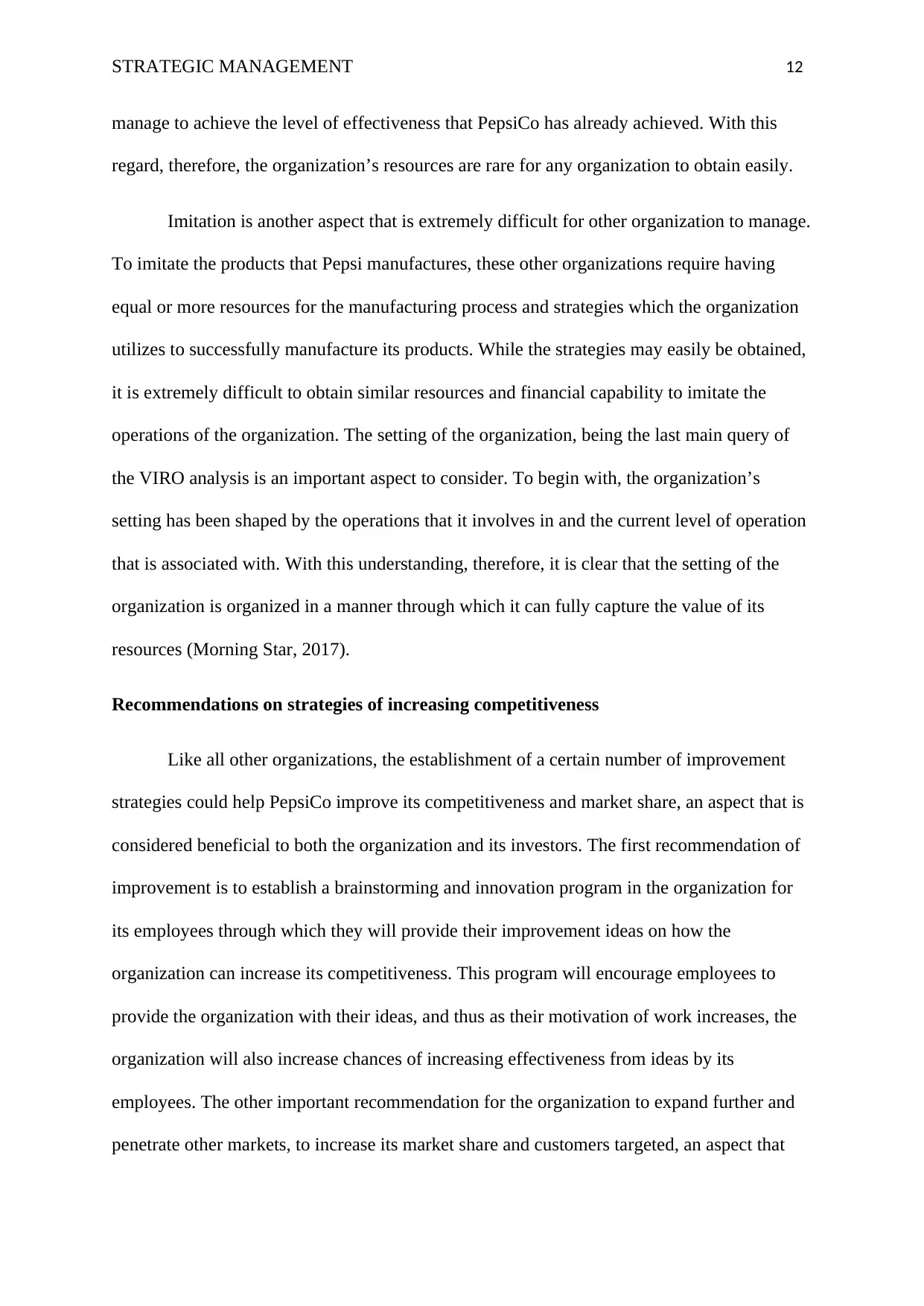
STRATEGIC MANAGEMENT 12
manage to achieve the level of effectiveness that PepsiCo has already achieved. With this
regard, therefore, the organization’s resources are rare for any organization to obtain easily.
Imitation is another aspect that is extremely difficult for other organization to manage.
To imitate the products that Pepsi manufactures, these other organizations require having
equal or more resources for the manufacturing process and strategies which the organization
utilizes to successfully manufacture its products. While the strategies may easily be obtained,
it is extremely difficult to obtain similar resources and financial capability to imitate the
operations of the organization. The setting of the organization, being the last main query of
the VIRO analysis is an important aspect to consider. To begin with, the organization’s
setting has been shaped by the operations that it involves in and the current level of operation
that is associated with. With this understanding, therefore, it is clear that the setting of the
organization is organized in a manner through which it can fully capture the value of its
resources (Morning Star, 2017).
Recommendations on strategies of increasing competitiveness
Like all other organizations, the establishment of a certain number of improvement
strategies could help PepsiCo improve its competitiveness and market share, an aspect that is
considered beneficial to both the organization and its investors. The first recommendation of
improvement is to establish a brainstorming and innovation program in the organization for
its employees through which they will provide their improvement ideas on how the
organization can increase its competitiveness. This program will encourage employees to
provide the organization with their ideas, and thus as their motivation of work increases, the
organization will also increase chances of increasing effectiveness from ideas by its
employees. The other important recommendation for the organization to expand further and
penetrate other markets, to increase its market share and customers targeted, an aspect that
manage to achieve the level of effectiveness that PepsiCo has already achieved. With this
regard, therefore, the organization’s resources are rare for any organization to obtain easily.
Imitation is another aspect that is extremely difficult for other organization to manage.
To imitate the products that Pepsi manufactures, these other organizations require having
equal or more resources for the manufacturing process and strategies which the organization
utilizes to successfully manufacture its products. While the strategies may easily be obtained,
it is extremely difficult to obtain similar resources and financial capability to imitate the
operations of the organization. The setting of the organization, being the last main query of
the VIRO analysis is an important aspect to consider. To begin with, the organization’s
setting has been shaped by the operations that it involves in and the current level of operation
that is associated with. With this understanding, therefore, it is clear that the setting of the
organization is organized in a manner through which it can fully capture the value of its
resources (Morning Star, 2017).
Recommendations on strategies of increasing competitiveness
Like all other organizations, the establishment of a certain number of improvement
strategies could help PepsiCo improve its competitiveness and market share, an aspect that is
considered beneficial to both the organization and its investors. The first recommendation of
improvement is to establish a brainstorming and innovation program in the organization for
its employees through which they will provide their improvement ideas on how the
organization can increase its competitiveness. This program will encourage employees to
provide the organization with their ideas, and thus as their motivation of work increases, the
organization will also increase chances of increasing effectiveness from ideas by its
employees. The other important recommendation for the organization to expand further and
penetrate other markets, to increase its market share and customers targeted, an aspect that
⊘ This is a preview!⊘
Do you want full access?
Subscribe today to unlock all pages.

Trusted by 1+ million students worldwide
1 out of 15
Related Documents
Your All-in-One AI-Powered Toolkit for Academic Success.
+13062052269
info@desklib.com
Available 24*7 on WhatsApp / Email
![[object Object]](/_next/static/media/star-bottom.7253800d.svg)
Unlock your academic potential
Copyright © 2020–2025 A2Z Services. All Rights Reserved. Developed and managed by ZUCOL.





